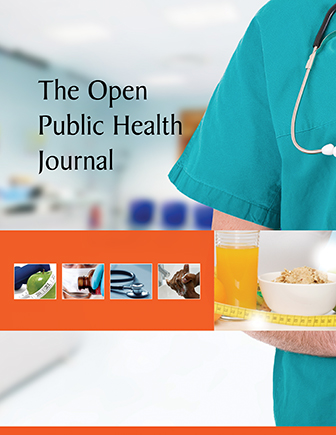All published articles of this journal are available on ScienceDirect.
Patterns and Behaviors during the Coronavirus Disease 2019 Pandemic in Germany: A Natural Language Processing Application
Abstract
Introduction
This study aimed to identify the underlying patterns and behaviors during the Coronavirus Disease pandemic for future preparedness and response strategies.
Methods
We applied natural language processing (NLP) techniques to interview data of qualitative nature collected from 40 German participants across various phases of the study. We then preprocessed the data well, getting rid of stop words, tokenizing, stemming, and lemmatizing the text, all done to ensure that the analysis would be meaningful and accurate.
Results
Significant terms from the term frequency-inverse document frequency (TD-IDF) analysis included noting the terms people, mask, vaccination, and vaccinated. Latent semantic analysis expressed major topics in phase I including discussions of experiences, vaccination, government, preventive measures, and public sentiment. Phase II consisted of vaccination efforts, government trust, and public coronavirus opinions, whereas phase III encompassed long-term impacts, trust in preventive measures, and changes in vaccination efforts. Sentiment analysis showed that negative sentiments are more (> 60%).
Discussion
The analysis showed that public concerns moved from compliance to skepticism and identified central themes, including vaccination, trust, and emotional burden. TF-IDF and LSA shed light on an evolving discourse in the pandemic, and sentiment analysis showed a pervasive distress. Such insights reinforce the importance of effective communication and mental health interventions during public health emergencies.
Conclusions
These findings help us to know more about the pandemic's impact a decade later that may inform future research, public health strategies, and policymaking.
1. INTRODUCTION
The Coronavirus Disease of 2019 (COVID-19) pandemic altered daily life across the globe, prompting extensive research into its social, emotional, and behavioral impacts. Creating public health strategies and policies that work requires understanding how people navigate these unprecedented times. This pandemic occurred at a time when large-scale data (structured and unstructured) was accessible to public health and healthcare institutions. Unstructured data comes in various forms that do not neatly fit into traditional data models. Managing and analyzing unstructured data poses challenges, which have historically hindered analysis and search efforts, making unstructured data less useful for these institutions [1-3]. However, with the rise of innovative technologies such as data-driven artificial intelligence (AI), the landscape has changed, enabling more effective analysis of unstructured data [1, 4].
NLP is an area of AI technology with a lot of promise [5-7], especially considering the vast amounts of free-text data that are already accessible and constantly being produced through various channels. NLP, including SA algorithms and machine learning techniques, has been successfully applied in automobile insurance fraud detection, online retail branding, customer service and satisfaction, job satisfaction, political lean, geoscience, and cybersecurity [8-15]. NLP has also been used in the COVID-19 pandemic for disease forecasting, early detection and prognosis (non-imaging), drug repurposing and early drug development, social media data analysis, genomic, transcriptomic, and proteomic data analysis, as well as medical imaging-based diagnosis and prognosis [16-18]. Nonetheless, most research and review articles on deep learning techniques for COVID-19 concentrate on image classification applications [19-24].
Few studies have examined NLP use in COVID-19 and its social, emotional, and behavioral impacts, and most research were focused on analyzing social media data [25-31]. Hence, there is a need to apply NLP to more robust data. Examining COVID-19 social, emotional, and behavioral impacts offers important insights into the impact of the COVID-19 pandemic on the general population and identifies strategies that can increase future pandemic preparedness and response. The study by [32] utilizes NLP to analyze interviews about the impact of COVID-19 in rural communities and compare it to thematic analyses obtained traditionally from a subset of the interviews. The literature we reviewed highlights research gaps in the application of NLP to datasets in a structured qualitative interview form rather than social media data, especially in the context of the sentiments during the pandemic. By demonstrating the power of modern NLP techniques in analyzing unstructured data, this study can offer a foundation for future research and inform public health strategies and policymaking efforts. Therefore, the aim of this research was to explore the underlying patterns and behaviors during the COVID-19 pandemic in the German population by analyzing interview data over different time intervals.
2. METHODS
In this work, we first collect data from Herbig, et al. [33] then advance to data preprocessing. Following pre-processing, we generate TF-IDF analysis and word clouds. We proceed to topic modeling and then sentiment analysis. Finally, we present the interpretation of the results. Our process is detailed in Fig. (1).
2.1. Data Source
In this study, we explored the experiences and sentiments of individuals in Germany during the COVID-19 pandemic by using comprehensive text analyses to examine the qualitative data collected in German from a longitudinal interview study conducted as part of the larger “Viral Communication” by Herbig, et al. [33] from interviews with 40 participants who were carefully selected from a nationally representative survey based on gender, age, and socioeconomic status. This full set of interview transcripts was treated as this study’s corpus with each participant, except for two who dropped out, was interviewed three times over [phase I (December 2020, 40 interviews), phase II (April 2021, 38 interviews), and phase III (September 2021, 38 interviews)] 10 months between December 2020 and September 2021. These semi-structured interviews were designed to delve deeper into survey responses and provide additional insights into topics and controversies surrounding the pandemic in Germany. Key focus areas included information and misinformation, trust and distrust, compliance, vaccination, and conspiracy beliefs [33]. The database is publicly available and was downloaded in August 2024 [33]. This study used publicly available, de-identified data; hence, no Institutional Review Board approval or informed consent was needed. The dataset can be downloaded directly from https://zenodo.org/records/66 73833.
2.2. Preprocessing
We translated the interviews from German to English using the Microsoft Word language translation tool, then leveraged the natural language toolkit to implement various data preprocessing techniques in Python (including figure production), ensuring an effective and unbiased analytical process. Translation from German to English was necessary to enhance preprocessing, as certain NLP tools are more reliable in English, and Microsoft Word with the CoPilot translation tool was picked mainly for its accessibility. Furthermore, the investigative team is not fluent in German, so translation was necessary to confirm results. These preprocessing steps included punctuation removal, tokenization, stop word removal, stemming, and lemmatization. We proceeded with several advanced text analysis methods after completing the data preprocessing. These included TF-IDF vectorization using TfidfVectorizer, topic modeling/LSA, word cloud generation, and SA. These techniques allowed us to gain deeper insights and uncover significant patterns within the dataset.
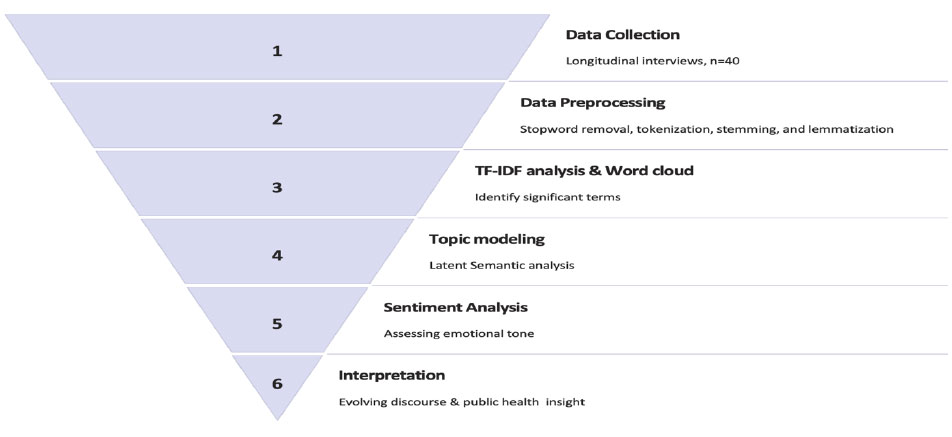
Study design flowchart.
2.3. TF-IDF
Machine learning algorithms typically require numerical data to function. Therefore, when working with textual data or any NLP tasks, it is necessary to transform the text into numerical data through a process called vectorization [34]. Hence, after cleaning the dataset, we began our text analysis by performing TF-IDF vectorization. We imported the “scikit-learn” Python library and utilized “sklearn.feature_extraction.text.Tfidf Vectorizer” to transform the collection of raw documents into a matrix of TF-IDF features. TF-IDF, a statistical measure used in text mining and information retrieval, was needed to evaluate the importance of specific words identified. As Schütze, et al. [35] mentioned, the central idea behind TF-IDF was to weigh the frequency of a word in a document against its frequency in the entire corpus (a collection of documents), thereby highlighting words significant to a specific document while diminishing the weight of commonly occurring words that were less informative. We identified the TF, the number of times the word appeared in the document, and IDF, the importance of the word across the corpus. The words were ranked based on the TF-IDF score (TF*IDF), which increased with the number of times a word appeared in a document (TF) but was offset by the frequency of the word in the entire corpus (IDF).
2.4. Word Cloud
We used the word cloud, also known as tag cloud, to visually represent textual data produced in Python software, where the importance of each work was indicated by its size or color. This visualization technique was chosen because it can highlight the most significant terms in a body of text, providing a quick and intuitive understanding of the main themes and concepts [36]. The more frequently a word appeared in the text, the larger or more prominent it was displayed in the word cloud.
2.5. Topic Modeling
We used topic modeling, a machine learning technique, to uncover the hidden thematic structure within a large collection of documents. Topic modeling helped us organize, understand, and summarize this large textual dataset, as well as identify the main topics. Additionally, it provided insights into the observed patterns and relationships [37]. The decision regarding how many topics to specify for each interview phase was vital; therefore, we employed domain knowledge and a series of tests (trial and error). This process identified the topics that provided optimal results and those that yielded distinct and interpretable topics.
2.6. Latent Semantic Analysis (LSA)
We applied LSA, a natural language processing technique using Scikit-learn’s TruncatedSVD in conjunction with a TF-IDF matrix. It was used to analyze relationships between a set of documents and the terms they contain, to uncover the underlying structure in our textual data. LSA transformed textual data into a mathematical space where the similarities and differences between words and documents were analyzed more effectively through a process that involves TF-IDF matrix creation, singular value decomposition, and dimensionality reduction [35].
2.7. Sentiment analysis (SA)
To gauge the tone, opinions, and emotions conveyed in the interviews, we conducted SA using Hugging Face transformers, leveraging their pre-trained pipeline model. This process, often referred to as opinion mining, was used to ascertain the emotional tone of the text. Based on SA, the text was categorized into positive, negative, or neutral sentiments [38].
2.8. ChatGPT
With the advancement in large language models, many now have the ability to perform various levels of text analytics. Based on this, this work incorporates ChatGPT as a mechanism to extract keywords from text to augment the results from classic TF-IDF.
Our choice of methods is based on layers of simple but foundational techniques that allow for vectorizing text to identify important terms in a document, uncover underlying structures in the data and reveal shifts in the psychological response of the public. Together, our methods provide a robust framework of both the emotional and informed experiences of participants.
3. RESULTS
3.1. TF-IDF
Based on the highest score of TF-IDF, we selected 10 words as the most significant or relevant captured in the interview. Table 1 highlights the most significant words for the interviews based on 3 phases. “people” (0.417468, 0.374612, 0.365573) achieved the highest score in all the phases. “mask” (0.222576, phase I), “vaccination” (0.201241, phase II), and “vaccinated” (0.281210, phase III) were the second words with the highest scores in their corresponding phases.
In Table 2, ChatGPT selected some words (“people,” “vaccination,” “trust,” and “pandemic”) for our TF-IDF analysis, meaning these words were common concerns across participants. TF-IDF provided information on words or expressions across interview phases like “wear,” “laughs,” and “question,” with term scores to indicate frequency. At a broader level, ChatGPT declared additional themes, such as “government,” “restrictions,” and “health”, without any metric.
3.2. Word Cloud
Figs. (2-4) visually represent the most frequent words from the three interview phases using word clouds. The word “people” appeared in all phases as the largest and most prominent in the word cloud. In phase I, the other most frequent words were “time,” “bit,” “simply,” “laughs,” “yes,” “lot,” “work,” “corona,” and “um.” In phase II, the other most frequent words were “laugh,” “bit,” “time,” “vaccination,” “vaccinated,” “simply,”” work,” “lot,” and “vaccine”/” difficult.” As well, the other most frequent words in phase III were “time,” “vaccinated,” “laugh,” “bit,” “vaccination,” “yes,” “year,” “work,” and “good.”
| Phase I | Phase II | Phase III | |||
|---|---|---|---|---|---|
| Term | TFIDF Score | Term | TFIDF Score | Term | TFIDF Score |
| People | 0.417468 | People | 0.374612 | People | 0.365573 |
| Mask | 0.222576 | Vaccination | 0.201241 | Vaccinated | 0.281210 |
| Time | 0.137680 | Vaccinated | 0.196536 | Vaccination | 0.213792 |
| Wear | 0.118117 | Laughs | 0.173009 | Pandemic | 0.208745 |
| Trust | 0.113687 | Pandemic | 0.158532 | Time | 0.205500 |
| Vaccination | 0.111842 | Mask | 0.151655 | Changed | 0.153224 |
| Simply | 0.110365 | Time | 0.135729 | Laughs | 0.145653 |
| Vaccinated | 0.108520 | Trust | 0.122337 | Question | 0.138803 |
| Die | 0.104090 | Masks | 0.113651 | Life | 0.112845 |
| Corona | 0.098923 | Question | 0.111117 | Trust | 0.099145 |
| Phase I | Phase II | Phase III |
|---|---|---|
| Term | Term | Term |
| Pandemic | Vaccination | Vaccination |
| Challenges | Lockdown | Corona |
| Health | Government | Masks |
| Trust | Restrictions | Government |
| Government | Trust | Restrictions |
| Vaccination | Virus | Trust |
| Mask | Masks | Virus |
| Social | Testing | Pandemic |
| Restrictions | Corona | Testing |
| Freedom | Pandemic | Health |
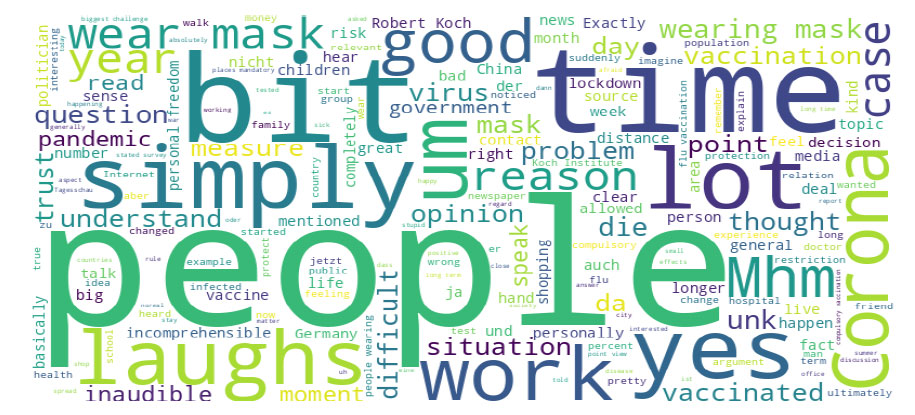
Interview phase I – most frequent words.
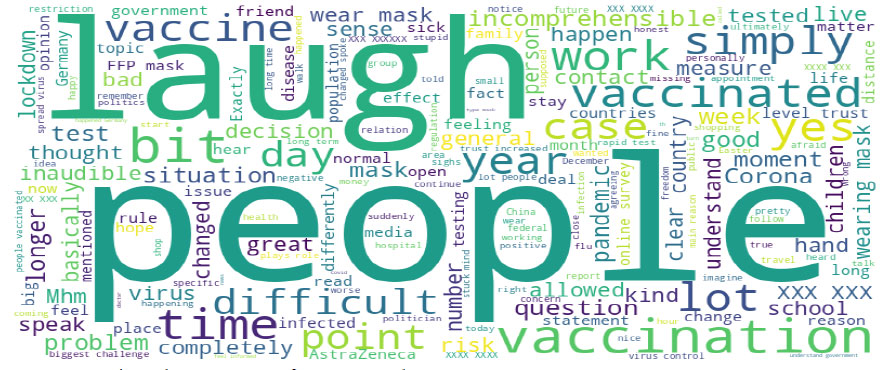
Interview phase II – most frequent words.

Interview phase III – most frequent words.
3.3. Latent Semantic Analysis (LSA)
LSA uncovered distinct themes within the interview transcripts, providing insights into the primary subjects of discussion. Key themes included discussions about the personal experience during the COVID-19 pandemic, vaccination, trust in government and preventive measures, and public sentiment. Below are presented the main topics by interview phases (including terms weight and interpretations) to better understand the content of the conversations or text data analyzed.
Topic 0
- Key Terms: “people” (0.031), “time” (0.014), “bit” (0.011), “lot” (0.010)
- Interpretation: This topic likely revolved around general discussions involving people and their experiences or activities over time during the COVID-19 pandemic. The terms “bit” and “lot” may be related to conversations about quantities or degrees of personal experiences during the COVID-19 pandemic.
Topic 1
- Key Terms: “mask” (0.078), “wear” (0.038), “people” (0.031), “wearing” (0.029)
- Interpretation: This topic was likely focused on the use of masks, including discussions about people wearing masks or related to health guidelines and safety measures during the COVID-19 pandemic.
Topic 2
- Key Terms: “man” (0.006), “war” (0.004), “okay” (0.003), “halt” (0.002)
- Interpretation: This topic appears to reflect personal or societal struggles during the COVID-19 pandemic. The term “man” could refer to individuals or broader discussions about the human condition during the crisis. “War” suggests a metaphorical reference to the fight against the pandemic, which was often framed as a battle.
Topic 3
- Key Terms: “yes” (0.019), “mhm” (0.012), “trust” (0.012), “question” (0.011)
- Interpretation: This topic may have involved conversational elements with affirmative responses (“yes,” “mhm”) and themes around trust and questioning. This could have been part of a dialogue or interview where trust is substantial.
Phase II
Topic 0
- Key Terms: “people” (0.034), “vaccinated” (0.014), “work” (0.008), “risk” (0.008)
- Interpretation: The emphasis on “people” suggests that this topic concerns the broader population, while the terms “vaccinated” and “risk” indicate a focus on immunization and associated safety concerns.
Topic 1
- Key Terms: “people” (0.034), “time” (0.011), “lot” (0.010), “vaccinated” (0.009)
- Interpretation: This topic may have involved discussions about people and time, possibly related to vaccination efforts and their impact on the population.
Topic 2
- Key Terms: “laughs” (0.029), “pandemic” (0.019), “question” (0.019), “bit” (0.012)
- Interpretation: This topic may have included conversational elements with laughter and discussions about the pandemic, likely addressing questions and experiences during this period.
Topic 3
- Key Terms: “trust” (0.037), “government” (0.028), “vaccinated” (0.025), “vaccination” (0.023)
- Interpretation: This topic may have focused on trust in the government and vaccination efforts, reflecting public sentiment and opinions on these issues.
Topic 4
- Key Terms: “survey” (0.018), “coronavirus” (0.017), “opinion” (0.017), “situation” (0.014)
- Interpretation: This topic may have involved questions and opinions about the coronavirus situation, likely gathering public views and attitudes.
Topic 0
- Key Terms: “vaccinated” (0.026), “yes” (0.025), “people” (0.022), “question” (0.016)
- Interpretation: This topic may have included discussions about vaccination, affirmative responses (“yes”), and general questions about people's experiences or opinions.
Topic 1
- Key Terms: “people” (0.039), “time” (0.022), “lot” (0.010), “longer” (0.009)
- Interpretation: This topic may have revolved around discussions about people and time, possibly related to long-term impacts or experiences.
Topic 2
- Key Terms: “trust” (0.031), “measures” (0.019), “survey” (0.018), “pandemic” (0.012)
- Interpretation: This topic may have addressed trust, pandemic measures, and interview results, reflecting public sentiment on these issues.
Topic 3
- Key Terms: “vaccination” (0.052), “vaccinated” (0.045), “changed” (0.038), “test” (0.012)
- Interpretation: This topic focuses on vaccination, changes brought by vaccination efforts, and testing, highlighting the dynamic aspects of the pandemic response.
Topic 4
- Key Terms: “laughs” (0.024), “situation” (0.019), “survey” (0.015), “pandemic” (0.013)
- Interpretation: This topic may have involved conversational elements with laughter, discussions about the pandemic situation, and survey results, reflecting public sentiment and experiences.
3.4. Sentiment Analysis (SA)
A sentiment score usually ranges between -1 and 1, with 1 indicating a strong positive sentiment in a task and -1 indicating a strong negative sentiment. In certain cases, there can be a score of 0, indicating a neutral sentiment or no emotional tone. (Figs. 5 and 6) illustrate Phase 1 sentiment distribution and scores. (Figs. 7 and 8) represent Phase 2, and (Figs. 9 and 10) illustrate Phase 3 sentiment distribution and scores. The figures represent the proportion of positive and negative sentences in the dataset that help to understand the overall sentiment distribution. Throughout all interview phases, the sentiments were negative (> 60%). The sentiment analysis indicated models were generally confident in their predictions, especially for negative sentiments.
4. DISCUSSION
This analysis of interview data collected during the COVID-19 pandemic (December 2020- September 2021) in Germany provided valuable insights into participants’ underlying patterns, behaviors, and sentiments. By employing various text processing and analysis techniques, including TF-IDF, LSA, and SA, we were able to uncover key themes and emotional tones present in the conversations. The TF-IDF analysis revealed terms such as “people,” “mask,” “vaccination,” and “vaccinated” were highly relevant, indicating their central role in their discussions. This finding suggested conversations often revolved around people's experiences and actions during the pandemic as it relates to interpersonal interactions or the lack thereof. These findings were similar to other studies that documented the pandemic’s impact on individual well-being, particularly examining isolation and its mental health impact [30, 39, 40]. Our findings also revealed the nuanced insights, concerns, experiences, and general sentiments of interviewees, highlighting the multifaceted nature of the human experience as it evolved during this global crisis, similarly observed in other research studies [28, 41, 42]. Finally, this research showed how AI tools can streamline the review and analysis of complex interview data, particularly on health-related topics such as the COVID-19 pandemic [43].
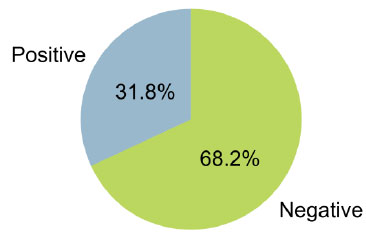
Phase I – sentiment distribution.
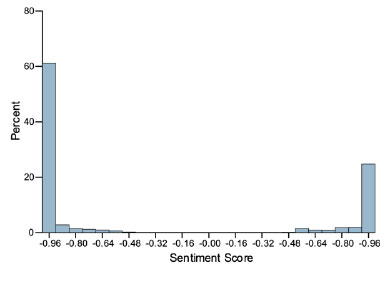
Phase I – sentiment score distribution.
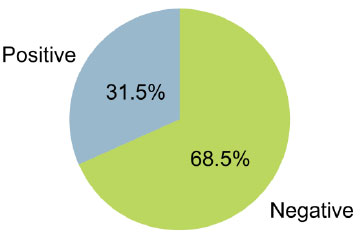
Phase II – sentiment distribution.

Phase II – sentiment score distribution.
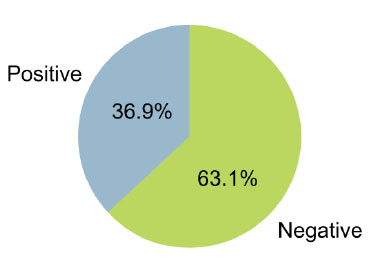
Phase III – sentiment distribution.
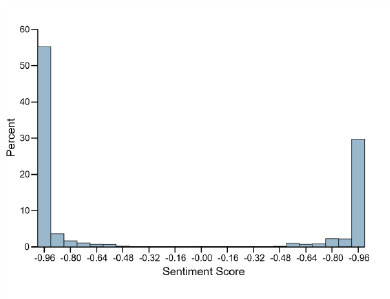
Phase III – sentiment score distribution.
LSA illuminated the thematic structure of the interviews by identifying key topics across different sessions. For instance, the phase I interview topics ranged from general discussions about people and their personal experiences over time to more specific conversations about mask-wearing and trust issues related to the coronavirus situation. Phase II interview topics included sensitive discussions with redacted information, as well as themes around vaccination efforts, government trust, and public opinions on the pandemic. Phase III interview topics highlighted ongoing discussions about vaccination status, the long-term impacts of the pandemic, and public trust in health measures and surveys. The issue of trust was a recurring theme with both skepticism toward the government and certain health protocols, particularly those related to vaccination. Some trusted the government, and some doubted the fruitfulness of pandemic containment. Masks, vaccines, and how people might adjust over time were all common topics. Those struggles (often metaphorically described as a “war”) still rankled, and people looked to humor for coping strategies. Public attitudes about time and lifestyle changes underscored the continued turmoil wrought by the pandemic [44-47].
A study by Han and Wang also explored semantic evolution during the COVID-19 pandemic among social media users, finding a constant change of topics throughout the pandemic, marked by the ultimate narrowing of a few topics as time progressed [48]. In our research, SA showed a predominance of negative sentiments over positive ones, reflecting the emotional toll and widespread impact of the pandemic on individuals' lives. This finding underscored the challenges and adversities faced by the participants during the COVID-19 period. The evolution of discussion topics and sentiment through the pandemic reflected the changing nature of the health crisis itself, moving from the immediate impacts of an individual’s change in their social life (i.e., lockdown, isolation, and quarantine) to broader themes such as public health communication.
By combining these analytical approaches, we have gained a multi-dimensional perspective on the COVID-19 pandemic's impact on selected individuals in Germany. The insights into key terms, thematic relationships, and emotional responses provided a comprehensive understanding of the participants' experiences. These findings can inform future research, public health strategies, and policymaking to better address the needs and concerns of the population in similar crises. For example, if public health practitioners can quickly identify the salient themes arising in large amounts of interview data, health messaging, and social marketing campaigns can be tailored to address the immediate needs of the population. Further, these techniques can be used to highlight and design interventions to decrease the health disparities seen in the hard-to-reach or vulnerable sub-populations observed both during public health emergencies and in non-pandemic times [49]. Additionally, emotional insights gained through sentiment analysis underscore the necessity of holistic approaches to health crises. While the immediate negative sentiment was likely related to the virus itself or the individual’s decision to vaccinate, the continued negative sentiment reflected the mental health toll of the prolonged pandemic response. This information would be particularly useful to public health practitioners and social marketers as they are helping communities navigate the long-term effects of a global pandemic through targeted interventions [50].
5. LIMITATIONS
This research demonstrated the power of modern NLP techniques in analyzing unstructured data, offering a foundation for future research and informing public health strategies and policymaking efforts. While this study offered valuable insights, it is important to note some of the limitations. The data used in this analysis were derived from interview transcripts translated from German to English from a diverse range of participants across several sociodemographic backgrounds. Nevertheless, all participants were in Germany during the interview time periods; thus, care should be taken when determining the generalizability of the results to other populations. Additionally, the interview data came from forty participants, so nuanced findings should be explored further with a higher-powered dataset used to research specific associations. Human emotions and experiences are extremely complex, and NLP techniques are constantly being refined to better understand the interactions and perceptions between individual experiences and global events [51]. As additional NLP techniques are developed and implemented, additional findings may provide further insight into human responses to pandemics. Despite these limitations, this qualitative data provided robust material for analysis to better understand how people coped with the COVID-19 pandemic over time.
CONCLUSIONS
Overall, this study highlighted the importance of understanding public sentiment and thematic concerns during public health emergencies, offering valuable lessons for tracking and managing such events in the future. The detailed examination of the interview data shed light on the critical issues and sentiments that shaped people's experiences during the COVID-19 pandemic. They also suggest that health responders should place emphasis on effective communication and emotional support strategies that reflect the needs of the public. Future research should consider how to integrate quantitative survey data with qualitative interview data to complement the findings derived from each method, whilst enhancing generalizability and interpretation by exploring divergent cases. By leveraging AI-driven methodologies, we can enhance our understanding of health issues and improve response to public health events, especially as it relates to vaccination uptake and health communication.
AUTHORS' CONTRIBUTIONS
The authors confirm their contribution to the paper as follows: study conception and design: H.W., J.S.; Writing the Paper: C.I.; Writing - Reviewing and Editing: J.T. All authors reviewed the results and approved the final version of the manuscript.
LIST OF ABBREVIATIONS
| AI | = Artificial Intelligence |
| COVID-19 | = The Coronavirus Disease of 2019 |
| SA | = Sentiment Analysis |
AVAILABILITY OF DATA AND MATERIAL
The data supporting the findings of the article is available in the Zenodo repository at https://zenodo.org/records/6673833, reference number 6673833.
ACKNOWLEDGEMENTS
We thank Deborah Harvey for her assistance with the manuscript figures.

